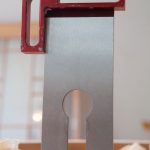We may receive a commission when you use our affiliate links. However, this does not impact our recommendations.

Yoav Liberman’s work has been featured in several woodworking books – most recently in “Robin Wood’s CORES Recycled,” and in American Woodworker and Woodwork Magazine. He’s also a regular contributor to the PWM Shop Blog. Yoav teaches woodworking at the Rudolf Steiner School in Manhattan, frequently guest teaches in craft schools across the country, and between 2003 and 2011 he headed the woodworking program at Harvard University’s Eliot House. He has a degree in architecture and held two competitive residency programs at The Worcester Center for Crafts in Massachusetts and the Windgate Foundation Fellowship at Purchase College, New York. Yoav will be teaching at Woodworking in America at the Northern Kentucky Convention Center, September 16-18.
What is it like teaching woodworking to young students professionally?
It is demanding but rewarding. In my school, teaching woodworking is mandatory. Most of my students show keen interest for working with wood and using hand tools, so whetting their appetite for our craft is not something I have to struggle with often. Although sometimes I have to work harder to come up with a plan to ignite interest in the hearts of one or two students who may not possess an inherent passion for woodworking. When teaching kids, you have to develop a system for presenting the fundamentals in the most clear and simple way – you do not want to confuse them with too much theory or with complicated techniques.
This is a great way to sort things in my mind, rethink about woodworking practices and come up with effective methods and logical reasonings. My approach is to break down a project into coherent step-by-step procedures while leaving some space for the students’ creative designs, so at the end the piece will be combination of a solid structure with unique individual input by the young woodworker.
One of the greatest rewards in teaching young students is to witness their “aha” moments when they discover something new either by watching me demonstrate to them a tool in action (e.g. they are thrilled to see, smell and touch thin shavings that come out of a hand plane) or when they successfully finish their project and all their classmates gather around to watch them as they apply a coat of flaxseed oil that lit the grain of their wood with spectacular colors.
Your drawings are one of our readers’ favorite parts of your blog entries. Why do you prefer to sketch by hand as opposed to using SketchUp or a different similar program?
I am thrilled that our readers enjoy the drawings and I believe that both myself and the readers are drawn to handmade illustrations because they are original, organic and very personal.
Let me explain…
I learned technical drafting in high school and fell in love with the endless possibilities that a pencil line over paper can provide. As time passed, and with more practice, I felt more and more confident relying on my hand and started to put the ruler and compass aside when sketching my ideas or when presenting them to colleagues and clients. This feeling, that your vision can somehow flow into your hand via dark pencil lines on a piece of paper that eventually lead to a two or three dimensional representation of an object is quite exciting.
However, free hand drawing has its drawbacks too. Unlike computer generated lines, a hand drawn line, especially one that doesn’t rely on instruments can hardly be perfectly straight. In addition, it is not that easy to draw parallel lines, and the circles you make are not pristine. Furthermore, in hand drawings one doesn’t have the luxury of easily creating – and “undoing”- lines, entities and layers, nor do they have the endless possibilities to effortlessly manipulate their objects, as a good 3D program can do. But, for me, the fluent, organic lines that my hand makes, this magical manifestation of the creative process is highly important. I find that drawing by hand resonates positively both with me and with my readers, which makes it so instrumental. I believe that this is why a realistic artistic rendering is so powerful to convey.
Another benefit for me is that hand drawing is, in many cases, a gradual process that begins, as do our thoughts, with some general ideas that need to be distilled. You begin with light, perhaps indecisive lines, and gradually as your shapes and thought mature you become more bold and defined….and so evolve the definition and darkness of your lines and surfaces as you corral in your creations to a safe destination. This is not, I believe, the case with computer lines that are created with algorithmic certainty from their inception and onward. Don’t get me wrong, I have used 3D computer programs and I value their contribution to the world of design but in the initial stages of design the hand drawings provide me more freedom and creativity and for this I like it so much.
You have an unusual way of acquiring materials for your projects. Can you explain how you hunt for materials?
The simple answer is: I open my eyes wide when I walk, ride my bike, or drive my car, and I am not shy of monitoring people’s trash.
I trained myself to identify the potential in stuff that we as a society decide to toss. Over time I came up with some practices that have proven successful: Often there are two times a year when people decide to purge their garages, basements and antics of old furniture, tools, lamps and more…much more. I try to identify when spring and fall cleaning periods take place and I’m extra alert to the piles that accumulate at the end of people’s driveways.
I try to pay attention to boxes labeled “free stuff” that are occasionally left on the curb by people of good conscience. A house with a “for sale” sign will begin to purge stuff as the sellers ready themselves to leave. On the last week of their residency much more stuff unfortunately will be trashed.
Many times I find great looking furniture that I can’t save (after all there is only so much that I can take) I try to take a pictures and text/email/post them to my friends and neighbors to convince them that they should adopt the orphan piece. Sometimes the pieces that I find are too damaged to be salvaged. In that case I try to save their hardware, but I stay away from plastic or die cast zinc handles or knobs.
I try not to pick up inferior materials or objects. I am not interested in plastics, MDF, chipboard etc,.
If I conclude that the objects that I saved will not be put for use by me or my family, or could not be incorporated in a new piece that I am interested in building, I will schedule their pickup by a charity organization or I will put them in a box on the sidewalk with a “Free stuff” sign affixed to it.
I have my boundaries too. I never open closed trash bags and I never lift dumpster’s lids to look what is inside….. I learned my lesson after I was once scratched by a squirrel who panicked trying to escape the “giant” who tried to break in into his dumpster.
Lastly, if you want to be a successful repurposer of materials, you need to have a strategy for storing them and be a sensitive and respectful towards the people who live with you and might not share the same passion to this practice as you.
Where do you get the inspiration for your designs?
From nature, architecture, technology, mythology, and most importantly the forms and personal history of the reclaimed wood and objects that I find. Sometimes it is easier to take the back seat and let a live edge slab formed by nature, or the tapered steel legs with the brass feet that I found, occupy the front seat and help steer the creative process for you.
Here are some supplies and tools we find essential in our everyday work around the shop. We may receive a commission from sales referred by our links; however, we have carefully selected these products for their usefulness and quality.









